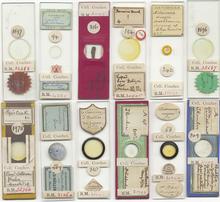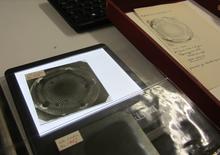THE PROJECT
‘Making the invisible visible; Thomas Comber and his diatom specimens’
In order to make the curation of the NHM Diatom collection more feasible and improve accessibility of this valuable resource we are focusing initially on a small but important part of these collections; the specimens found in the collections of Thomas Comber.
Detailed information about our (NHM) diatom collections is scattered and very little has been databased.
The slide collections are labeled with varying degree of completeness, and much of the collection relies almost solely on a hand-written card index as its primary ‘finding aid’ or on handwritten notes made by those that studied the collection in the past. It is very difficult to know what we have at (taxonomic) species or at geographical level as the material (i.e. slides, bottles with raw material, etc) is organised by Collection/collectors.

A one year project entitled ‘ Making the invisible visible; Thomas Comber and his diatom specimens’ will convert these data into a modern electronic format, and help to create an all in one efficient system for access to these collections be it for novice or expert study, research or other interests. It was created to make available species data, images and/or literature as well as to promote T. Comber collection which also contains types and material from the H.M.S. Challenger expedition.
This expedition was the first ever oceanographic voyage, create to explore the deep ocean and document the existence of life there with many samples taken from the ocean bottom.
Find out more about the HMS Challenger expedition here:
http://www.nhm.ac.uk/nature-online/science-of-natural-history/expedition...
It is hoped that by focusing initially on Thomas Combers’ collections not only can we focus our attentions clearly to a significant end but we will also gain valuable insight into generating an efficient system for curating and digitising the rest of the collections going forward.
Why is this project important?
Right now, around 12 -15,000 diatom species are known, but it remains possible that there may well be over 250,000, most still living somewhere on the planet, yet to be discovered. With very few exceptions diatoms are invisible to the naked eye so we aim to raise awareness of these unique and beautiful organisms and their importance to the symbiotic relationship with marine and freshwater ecosystems.
By carrying out this work collaboratively with volunteers we will unify all the disparate elements of the diatom collections (slide, bottle, notes, drawings, etc) related to T. Comber, into an all in one efficient system via Scratchpad for access be it for novice or expert study. It will also expose the potentials of these collections either for geographical or taxonomic related subjects such as listing new species or new range of occurrence, as well as have the opportunity through the scientific community, to have a collection with updated taxonomy. Moreover, the data and the collection could be also used for ecological and/or environmental related studies.


The project also fits closely with the Museums' Science Strategy including Science Infrastructure, where collections are developed by improving accessibly and utility of collection data in both the physical and virtual realms; and also helping towards our ambition of a digital NHM.
Outcomes of the project
1. to unify and cross-reference all the disparate elements and information of the diatom collections (e.g. slides, bottles, notes: usually hand-written, drawings, etc.) that is related to a species and/or locality, found on T. Comber collections and notes.
2. To make available via a Scratchpad portal species data, some taxonomic notes (e.g. Types), images, related information and/or literature exposing its potential for novice or expert/research studies or other interests.
3. To promote the Thomas Comber collection which also contains types and material from the H.M.S. Challenger expedition
4. To engage volunteers in our work in a meaningful way with our collections
5. To bring the tiny and invisible world of diatoms alive and improve and increase the awareness and access of these organisms and our remarkable collections of them